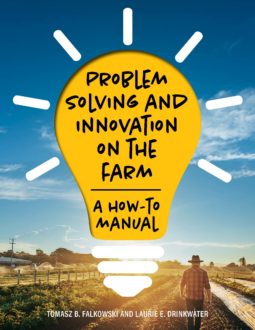This manual is designed to help farmers improve operations by combining problem-solving and experimentation with day-to-day farm management. The step-by-step process outlined is based on the know-how of experienced farmers who have developed innovative approaches for adapting their farms to changes. By explaining the techniques these farmer innovators use, the manual provides information on how to successfully identify research questions, test alternative solutions, and collect data on the farm.
Table of Contents
- Chapter 1 – Introduction
- How this manual was developed
- Content and organization of the manual
- Chapter 2 – How do expert farmers solve problems on their farms?
- Overview of the Problem Solving and Innovation Framework presented in this manual
- Adaptive whole farm management
- The role of farmers in agricultural research and innovation
- Fostering problem solving and innovation
- Problem solving or innovation?
- Chapter 3 - Establish life and farm goals
- Step A: Identify a farm vision
- Step B: Define the farm system
- Recommended resources
- Chapter 4 - Identifying problems and opportunities
- Step C: Observe and gather information on the farm system
- Step D: Evaluate the farming system
- Recommended resources
- Chapter 5 – Problem solving and experimentation
- Step E: Design actions
- Step F: Implement the plan
- Step G: Evaluate outcomes
- Recommended resources
- Chapter 6 – Example experimental designs
- Trials repeated over time without a control or replication
- Unreplicated side-by-side comparisons with a control treatment, repeated over time
- Side-by-side comparisons with a control treatment, replicated in multiple fields
- Side-by-side comparisons with a control treatment replicated in a single field
- Randomized, complete block designs
- Chapter 7 – Case studies
- Case Study #1: Setting goals and determining quality of life requirements (Anton Burkett, Early Morning Farm)
- Case Study #2: Observing patterns (Jean-Paul Courtens and Jody Bolluyt, Roxbury Farm)
- Case Study #3: Developing a cropping system and a unique market niche (Thor Oechsner, Oechsner Farms)
- Case Study #4: Adapting to climate change through innovative management (Lou and Merby Lego, Elderberry Pond Farm)
- Case Study #5: Background investigation (Klaas and Mary-Howell Martens, Lakeview Organic Grain)
- Case Study #6: Experimental Design (Lou and Merby Lego, Elderberry Pond Farm)
- Case Study #7: Success criteria (Karma and Michael Glos, Kingbird Farm)
- Case Study #8: Evaluating results (Chaw Chang and Lucy Garrison, Stick & Stone Farm)
- Case Study #9: Invite feedback from collaborators (Harold Schrock, Berry Hill Farm)
- Case Study #10: Reinventing a whole farm system (Adam and Courtney Squire, Unbound Glory Homestead)
- Case Study #11: Developing an innovative farming system (Steve Groff, Cedar Meadow Farm)
- Chapter 8 – Appendices
- Appendix I: Established farmer networks and agricultural organizations
- Appendix II: Sample resource inventory worksheet
- Appendix III: Grants for farmer experimentation
- Appendix IV: Personal weather stations
Want more information? See the related SARE grant:
- Research and Problem-Solving on the Farm (ENE15-135)
This material is based upon work that is supported by the National Institute of Food and Agriculture, U.S. Department of Agriculture through the Sustainable Agriculture Research and Education (SARE) program. Any opinions, findings, conclusions, or recommendations expressed in this publication are those of the author(s) and should not be construed to represent any official USDA or U.S. Government determination or policy.
